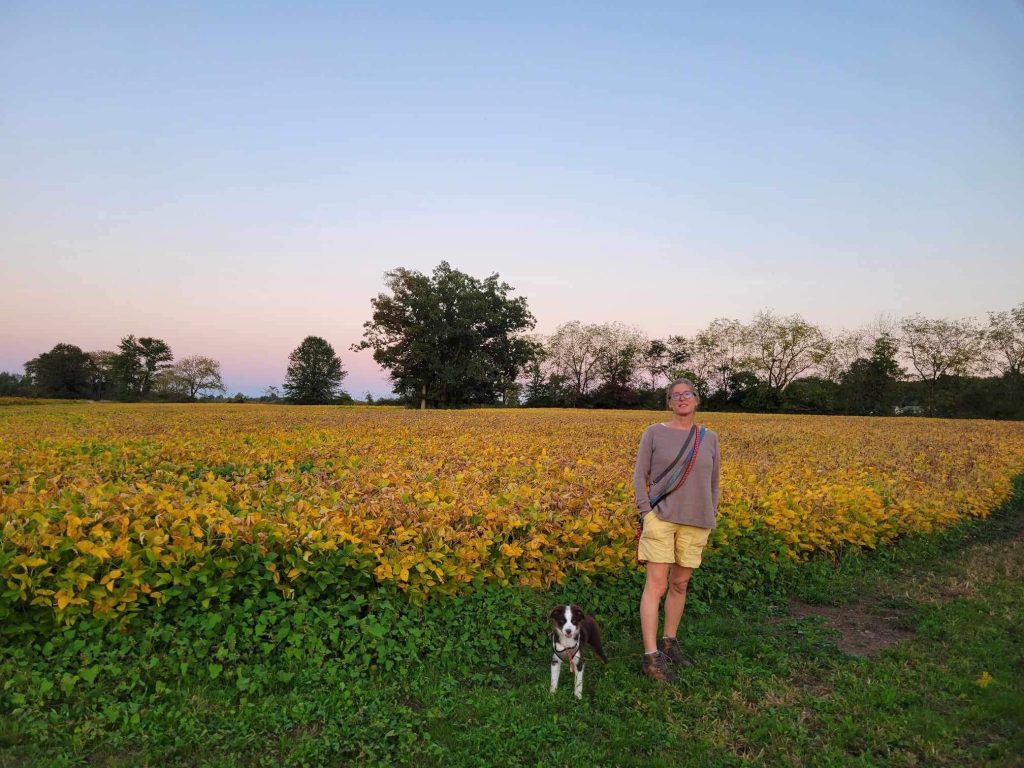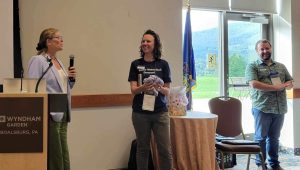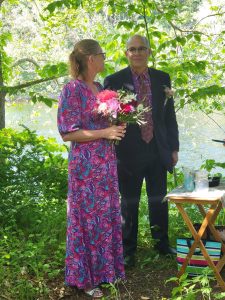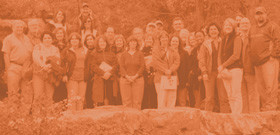The D&L Blog


An Island in the Atlantic
Growing up in Manhattan meant Rebecca Hayden was never a stranger to the impacts industry has on our waterways. Spending her childhood primarily along the Hudson River in New York City, she spent weekends and summers in the Catskill Mountains. The contrast between the heavily impacted Hudson River Estuary in the city, and the pristine waters of New York City’s protected upstate watershed made an impression. Environmental activism – the passage of the Clean Water Act in 1972, the intense protests around the No Nukes movement taking place on the landfill expanding Manhattan Island (now Battery Park City) – drew Rebecca’s interest.
Another factor was the activism of her parents, who had been deeply involved in the racial justice and gender equality movements, starting in the early 60’s. Rebecca came into her teens with a strong value that everyone should make a difference. Her interest only continued to grow over the years, following her through high school, college, and graduate school. Rebecca would graduate from Columbia University with an undergraduate degree in geology and a Master’s degree in engineering hydrology from the University of New Mexico. She had planned to continue her education, however, at the time her first of four children was on his way and she decided to shift gears. Taking a job for the USDA Forest Service as the District Hydrologist for the northern portion of the Santa Fe National Forest, she spent time doing Spotted Owl surveys and working potential timber sale areas to prevent resource impacts.
Lehigh County Conservation District

After moving from New Mexico to Pennsylvania, Rebecca would begin working in the Lehigh Valley in 2002 as Lehigh County Conservation District’s first Watershed Specialist. Soon she hired Erin Frederick (the current Penn State Extension Statewide Master Watershed Steward Program Coordinator). Together they worked on water sampling collaboratively with the Pennsylvania Department of Environmental Protection, designing and building on-the-ground projects, and carrying out outreach and education programs throughout the Lehigh Valley.
“I have a background in stream design, and I did a lot of conservation management planning. We created a conservation management plan for the Saucon Creek, the Coplay Creek, and various other areas. During this time, Lehigh Valley Greenways also got its start, and we began working on a lot of stream restoration projects. In doing so, we became involved with a lot of the local watershed associations.”
Over time, Rebecca noticed a common theme amongst the watershed associations she worked with. Despite environmental and water resource health consistently placing within the top concerns Americans had within their communities, many watershed associations were struggling. There were often only a few people with limited resources. Some groups felt isolated and ‘burned out.’ Watershed associations were looking for new energy.
“So, one of the things that we did starting around 2007-2008 was we decided to form the Watershed Coalition of the Lehigh Valley.”
The Creation of the Coalition
At the time, Rebecca served on the Board of the Green Valley Coalition, a non-profit organization that had been created in the 1990’s to advocate for green infrastructure and sound stormwater management practices. But with the adoption of new stormwater regulations and the acceptance of greener development practices, the Green Valley Coalition had largely met its original goals. At a Green Valley Coalition meeting around 2007, the idea was pitched to ‘transform’ the organization into a coalition that would help to strengthen, connect, and re-energize the region’s watershed associations. And from that idea the Watershed Coalition of the Lehigh Valley was born.
“It was an exciting time. Lehigh Valley Greenways was getting rolling, and there were new resources flowing into the Valley. Over several years, all the regional conservation organizations came together – the Wildlands Conservancy, the Delaware & Lehigh National Heritage Corridor, the Conservation Districts, and the local watershed associations – the Cooks Creek, Saucon Creek, Martins-Jacoby, Bertsch-Hokendauqua -Catasauqua, Monocacy, Fry’s Run, Perkiomen, and Bushkill groups. It took time, but after several years, the Watershed Coalition of the Lehigh Valley was up and running.”
“Over the past 15 years the Coalition has grown and added new watershed groups, helping to form a few new ones, and adding groups from the Poconos and Bucks County as well. Our last Board meeting had 25 people attend, and each meeting is filled with energy as groups and individuals share resources, exchange ideas, and support one another.”
One of the ways Watershed Coalition of the Lehigh Valley achieves its vision is through the sharing of resources and connections through their website and email. The Coalition general email inbox receives questions related to personal and professional projects, or just general information. If someone has an idea for a project, Rebecca and others on the Coalition board will make sure they get in touch with the right people to make it possible.
The Coalition has also started purchasing equipment to help with on-the-ground projects available to loan to all its members. The Watershed Coalition of the Lehigh Valley now owns tree and plug augers, chainsaws, and various other tools that many organizations often do not have access to.
For Rebecca, the most important thing as President of the Board is empowering individuals and groups to “accomplish what it is they want to accomplish.”
Too Many to Count
When asked what her proudest achievement in her conservation career is, Rebecca had a hard time narrowing it down.
Back in 2013, Rebecca, Erin, and Jim Wilson of Northampton Parks got together to create the Penn State Extension Master Watershed Steward Program. The initial launch was successful in Lehigh and Northampton counties, garnering interest from other counties as well. Moving first locally into Montgomery and Bucks Counties, the program is now active in 42 counties across the Commonwealth. There are now over 1,000 trained Master Watershed Stewards; Rebecca acts as the Chair of the Statewide Steering Committee for the program.
The Coalition has also held nine Watershed Conferences since 2014 in collaboration with Lehigh University, the Nurture Nature Center, the Conservation Districts, and other regional organizations. These conferences bring in people from across the country to discuss national and local issues regarding water health and safety. Their last conference was held on March 14 of 2023 and was called Endemic Watershed Connections: Place. Preservation. Restoration.
According to Rebecca, some of the projects she finds most memorable are the ones that meet a little bit of resistance at first.
“We have a project at the Lower Saucon Sportsmen’s Association (a Lehigh Valley Greenways Mini-Grant funded project) where the group refused to put in a riparian buffer for the last 20 years. Recently, they finally agreed and now they’re in love with it. I really like those projects where people’s minds are changed.”
Nevertheless, Rebecca’s favorite project, “hands down,” was the creation of the Landmarks and Waterways Exhibit, currently on display at Moravian University’s student center.
“It is the first and only project I have ever done in my life that’s partly funded by the National Endowment for the Arts. I’m a scientist, right? Making these pieces of artwork has just been moving and stunning. Discovering the intersection of art and science and how incredibly powerful that is, it’s been incredibly inspiring.”
Wedding on the Delaware & Lehigh in Upper Black Eddy
Rebecca, her husband Ross, and their two dogs, Tai and Juno, are not just members of the conservation community – they are frequent trail users. Ross is an avid whitewater kayaker, a Master Watershed Steward, and has his own lifelong history with the Delaware River watershed and its conservation, growing up in Bethlehem Township and Easton. When deciding where to marry after over a decade together this spring, Ross and Rebecca decided upon the banks of the Delaware River, just off the D&L Trail: Ringing Rocks Trailhead in Upper Black Eddy with a dinner afterwards at canal-side restaurant The Narrows.
A Word from Brit
As president of Watershed Coalition of the Lehigh Valley, Rebecca has worked with multiple people across the Valley, as well as within our own organization. Most recently though, she works with Delaware & Lehigh National Heritage Corridor Conservation Coordinator Brit Kondravy through the Lehigh Valley Greenways Conservation Landscape program.
“Lehigh Valley Greenways Leadership members, ‘wear many hats,’ as we like to say, and are often busy working on multiple projects with multiple partners while fulfilling multiple roles. But it’s possible Rebecca Hayden is the busiest person I have ever met,” said Brit Kondravy. “From her job at PENNVEST to leading the Watershed Coalition of the Lehigh Valley as an extremely engaged President, Rebecca Hayden is almost always in-motion.”
“Her commitment to natural resource protection drives collaborative projects forward. The Watershed Coalition of the Lehigh Valley utilizes Lehigh Valley Greenways mini grant funding to support riparian buffer plantings throughout the Lehigh River and Delaware River watersheds. As a result, Rebecca plays a critical role in advancing Lehigh Valley Greenways’ environmental restoration goals. I am honored to work with her and appreciate her ability to maintain a sense of humor even in challenging situations.”
Want to Get Involved?
The Watershed Coalition of the Lehigh Valley is a valuable resource within the Lehigh Valley. Click on a linked watershed association listed on DLNHC’s Take Action landing page and chances are high you’ll find yourself on the Coalition’s website.
If you are looking to get more involved, Rebecca says,
“The Watershed Coalition will figure out how to connect you with whatever it is that interests you. Whether that be becoming a Master Watershed Steward or a member of a watershed association, engaging more effectively with your municipality, or even figuring out what to do with the rain garden in your backyard or your streambank. If you have any questions or worries regarding environmental concerns within the in Lehigh Valley, please feel free to reach out.”
This article was written in collaboration with Watershed Coalition of the Lehigh Valley as part of the DLNHC Faces of the Corridor campaign. If you would like to read more of the campaign, visit this link.













